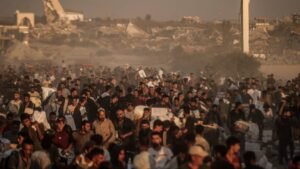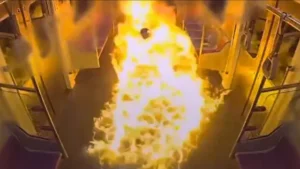Iran nuclear sites satellite images
During the 12 days tensions between Israel and Iran, US launched Operation Midnight Hammer on Iran’s nuclear three nuclear facilities – Fordow, Isfahan and Natanz military operation of stealth and military might.
US President Donald Trump has claimed that the US strikes on Iran’s nuclear sites were “a perfect operation.”
The Pentagon held a press conference to address growing questions surrounding the recent U.S. strikes on Iran’s nuclear sites, following reports that an early assessment of the damage had been leaked to the media earlier this week.
While International Atomic Energy Agency (IAEA) said that as a result of Israeli and US strikes, the agency has “seen extensive damage at several nuclear sites in Iran,” including those three. Israel claims it has set back Iran’s nuclear program by “many years.”
The question rises: How much damage did the US strikes cause to Iran’s nuclear program? Let’s take closer look
‘Most secret, complex US operation’
General Dan Caine, Chairman of the Joint Chiefs of Staff, revealed that so many experts were involved in designing the bombs used in the US strikes that they became the “biggest users of supercomputer hours within the United States of America” at one point.
The 37-hour-long mission was executed by a crew composed of both men and women, ranging in rank from captain to colonel. Most were graduates of the elite Air Force Weapons School in Nevada.
“When the crews went to work on Friday, they kissed their loved ones goodbye, not knowing when or if they’d be home. Late on Saturday night, their families became aware of what was happening,” Caine said.
After what the US deemed a successful operation, the B-2 Stealth bombers returned to Missouri, where they were welcomed by the crew’s families. “Waving flags and tears were flowing,” Caine added.
Defense Secretary Pete Hegseth described the attack as “the most secret and most complex military operation in history,” though he declined to share further operational specifics.
Iran fortified Fordow
Caine disclosed that US intelligence observed Iranian crews attempting to conceal the main shafts of the Fordow enrichment facility by pouring concrete over them in the days leading up to the mission.
He said, “The planners had to account for this. The cap was forcibly removed by the first weapon and the main shaft was uncovered.”
“I won’t share the specific dimensions of the concrete cap. But you should know that we know what the dimensions of those concrete caps were. The planners had to account for this. They accounted for everything,” Caine added.
Despite Iran’s reinforcement efforts, the mission proceeded as scheduled, with 30,000-pound bunker-buster bombs performing “as designed” on their first attempt, Caine highlighted. Around 44 soldiers and two Patriot missile batteries were also deployed nearby to defend against any potential Iranian response.
No evidence of Uranium removal
Amid rising speculation over whether Iran had moved enriched uranium before the US strikes, both the Pentagon and the White House firmly denied any such activity.
“There was no indication to the United States that any of that enriched uranium was moved prior to the strike from any of the sites,” said White House Press Secretary Karoline Leavitt.
President Donald Trump wrote on Truth Social, “The cars and small trucks at the site were those of concrete workers trying to cover up the top of the shafts. Nothing was taken out of the facility. Would take too long, too dangerous and very heavy and hard to move.”
Leaked DIA report
A leaked Defense Intelligence Agency (DIA) assessment, reported by AFP, has cast doubt on the Trump administration’s claims about the effectiveness of Operation Midnight Hammer.
The confidential five-page report, published by news agencies on June 24, stated that the recent U.S. strikes failed to destroy Iran’s underground nuclear facilities and only delayed its nuclear program by a few months.
According to the DIA, Iran’s nuclear weapons timeline was extended from three to six months. The report also revealed that much of Iran’s enriched uranium stockpile had been moved before the strikes, resulting in minimal destruction of nuclear material.
A Washington Post source familiar with the report confirmed that some centrifuges used for uranium enrichment remain intact.
















